When we finally turned to the last page of my proposal, I figured the gig was up.
It was now time to talk money, and this number would surely get me thrown out of the house. I’ve been dismissed from potential customers’ kitchen tables for less!
The response back at me was immediate, without even an uncomfortable shift in the chair.
“When can you start this? I want my grandkids to enjoy this pond.”
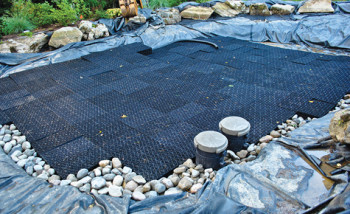
The 4-year-old pond had never been clear and healthy. As my new client prepared the deposit I gazed out the kitchen window at 400,000 gallons of pond water looking an awful lot like the chocolate river at Wonkaland on St. Patrick’s Day. I promised to give them clean, clear pond water that could support “those colorful koi fish” my client wanted. I promised “a pond they can LIVE with,” and my plan was good.
As the deposit check was passed into my hand, I thought to myself, “Gannon, what the hell did you just do?” And the biggest pond project my company, Full Service Aquatics, has ever taken on was underway.
Starting From Scratch
A string of landscapers and pond guys had previously offered a string of solutions. “Drain it and fill,” one suggested, only to find that the clear, new water filling the pond was immediately turbid. “Aeration,” suggested another, which made the effect worse. Flocculants were used, added daily for months, with no effect. Dyes made the pond look unworldly. The “wetland filter” installed by the last “disappearing pond contractor” became impacted and useless within days. As the project began, the water quality looked like Yoo-hoo with a slight green-blue tint.
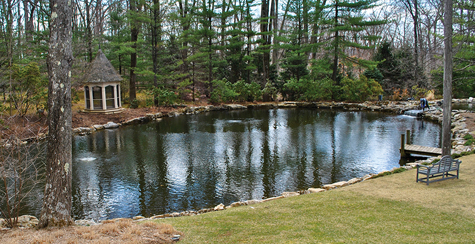
The pond is the main landscape feature of the large estate, made up of an upper and lower pond connected by a spillway. Both have very large moss rock boulders along their shorelines. The main pond had an exposed mud bottom and measured in at about 150 feet by 100 feet with an average depth of 4 feet and a maximum depth of 8 feet. The upper pond area was intended to be a “wetland filter” area measuring about 55 feet by 40 feet. The upper pond was fed by two large external pumps. Thoughtlessly displayed along the shoreline, the pumps sucked turbid water directly from the pond bottom without any prefilters, spilling back into the lower pond via an unimaginative, large, flat slab of bluestone.
There was no way I would take on attempting to correct the numerous issues created by several other contractors. The only option I offered was complete renovation; a fresh start to achieve 400,000 gallons of clean, clear, filtered, koi-quality water conditions.
The Plan
- Drain the upper and lower ponds completely and remove all existing equipment
- Install geotextile liner to lower pond; install 45-mil EPDM liner to upper pond
- Fabricate undergravel suction/backflow grid
- Cover liner of lower pond with mixed grades of gravel substrate from 3/4 inch to 8 inches
- Build two shoreline skimming zone intake bays in lower pond
- Install professional-grade aeration system with two diffusers in lower pond
- Convert upper pond into massive planted wetland filter with waterfall feature
- Create beautiful natural stone waterfall spillway from upper pond into lower pond
- Get some koi
The Materials
- A bunch of wheelbarrows and a Case 510 backhoe
- 15-foot-wide rolls of geotextile, and lots of it
- A single 100-foot by 50-foot roll of EPDM liner
- Aquablocks, centipede modules and snorkel pump housings
- 4” Flex PVC pipe and fittings
- Three 15,000-gph submersible pumps
- Drilled drainage pipe
- Twin diffuser aeration system
- 250 tons of gravel and stone
- 400,000 gallons of water
- Lots of aquatic plants
- Koi
Pulling It Off
I planned for an 18-day project timeline. The first step was to drain the pond, and this took three days! While draining the pond, we staged the project site and received deliveries, and the crew broke down the existing “wetland filter.” The gravel in this “wetland filter” was so compacted that it bonded together like concrete; it was a tough process to jackhammer this solid block of gravel. Once we got down to bare liner we stripped it out and began reshaping, enlarging and deepening the shallow bowl we discovered. We excavated the interior of the upper pond for the construction of an effective wetland filter.
The lower pond was dewatered now, and no excavation was necessary in the lower pond. The geotextile lining of the lower pond went the length first, then crossed the pond with edges overlapping each other about 3 feet. Along the shoreline we lifted the massive rocks, quickly tucking geotextile under and behind each boulder. The geotextile lining was not intended to hold water; instead, it was used to separate the pond’s mud bottom from the water column. The lining of the pond would create an instant clearing effect.Once the ponds were lined my team broke into two crews. One crew focused on constructing the wetland filter and suction grid, while the other crew revved up their wheelbarrows and began the first of many days of hauling gravel over a boardwalk of plywood to begin the rocking in of the lower pond. Progress was made until the bottom of the pond was covered. The wetland filter was constructed with centipede modules and snorkels covered with a bed of Aquablocks.
Once the main pond was rocked in, the gravel and stone team switched their focus to the newly assembled wetland filter. The equipment team jumped into the main pond for construction of the two skimming zones, installation of plumbing lines and aeration system.
Skimming and Clearing
The skimming zones allow for a complete circulation pattern on the surface of the pond, drawing floating debris away from the main shoreline of the pond. Large intake bays allow for easy collection of floating debris and maintenance access. The skimming zones would collectively draw in 45,000 gph by way of the three 15,000-gph submersible pumps. The series of 4” plumbing lines run from the skimming zones to the wetland filter and suction grid.
The aeration system’s two powerful diffusers circulate water from the bottom of the pond to the surface, efficiently degassing and oxygenating the pond.

The wetland filter was turned into a thing of beauty. We created “raised beds” within the filter by framing out the edges of the wetland filter with boulders and backfilling with gravel. The beds rise 8 inches or so above water level, creating a pond in the middle of these beds to house water lilies and lotus. The raised areas were for varieties of nutrient-absorbing bog plants. A decorative, 10,000-gph waterfall within the wetland filter was added as well. The flow coming out of the wetland filter will cascade over a redesigned moss rock waterfall spillway into the lower pond. 20,000 gph will flow up through the wetland filter’s bed of gravel to be joined by the 10,000 gph flowing out of the waterfall display to create our new 30,000-gph naturalistic spillway into the main pond.
No Garden Hose Will Do
The construction phase of the project was coming to an end, and it was time to clean the worksite and fill the pond. A garden hose was not going to fill this pond! While the team picked up, cleaned, raked, mulched and detailed the project over the next several days, a steady stream of 6,000-gallon water tankers made their way to the site to unload their cargo.
When the pond was full, it looked amazing. The pristine water had a clear, Caribbean-blue quality to it, with glints of sunlight. I knew this Caribbean look was only a temporary effect that would change once the pond had circulated for a few days, and it was time to start circulating the pond and testing all the systems we had installed.
Testing
First we tested the aeration system. We plugged in the remotely located compressor, and a few seconds later we had two points of aeration happily bubbling away on the surface of the pond.
Next up were the skimming zones. Each zone’s pump was plugged in, one at a time, and each pump responded with a strong draw of water flowing into the new skimming zone intake bays and our under-gravel suction grid.
[box]The filling (left) of several hundred thousand gallons of water into the pond.The pond was rocked and graveled after the main lining system was installed.[/box]
When the last pump was plugged in, the wetland waterfall display in the wetland filter roared to life with 10,000 gph of whitewater splashing down the face of the moss rock waterfall.
Everything was coming together nicely, sounding good and looking good. The wetland basin was filling, and soon water would be welling up between the grains of gravel and continuing to fill, creating the upper pond. This, in turn, would overflow via the waterfall spillway into the main pond. 30,000 gallons were now making their way over the spillway. The clear water looked beautiful, and the waterfall sounded just as beautiful. Our client’s pond was now fully functional.
Waiting in Suspense
My clients are private people. Since I could not be there when my clients returned home, I was anxious for the call from them to come in. My mind ran with every possibility as to how they could react. Would it be a tearful “Thank you”? Or would I be brutally tossed into the very pond I created for them? Would the gig be up?

Luckily our clients were happy—very, very happy. For a pond professional, there is not a much better feeling than to well exceed your client’s expectations. And before the “walk-through” with my clients even ended, they both wanted to know the answer to a burning question: “When can we get the koi??”
The next week they had 13 large, beautiful Japanese koi (some with certified bloodline birth certificates), and the following week those koi spawned! Now my clients have many hundreds of baby koi creating a moving swirl of living color in their pond—in addition to the 13 impressively large koi! My clients could not be happier, their grandkids love it, and their new koi pond is now “a pond they can LIVE with.”
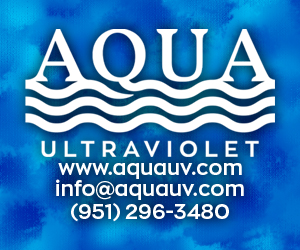
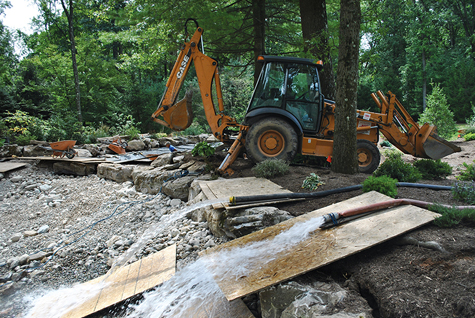
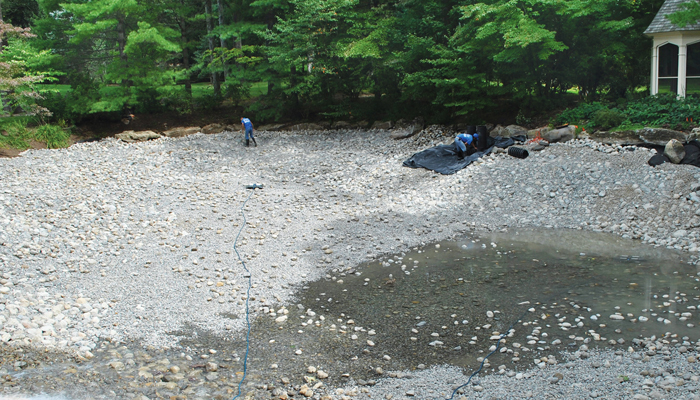


All I can say is this company sure knows their stuff! I might also say this was a very interesting article. A great story with a happy ending. Very well written.
Very nice. Professional job!